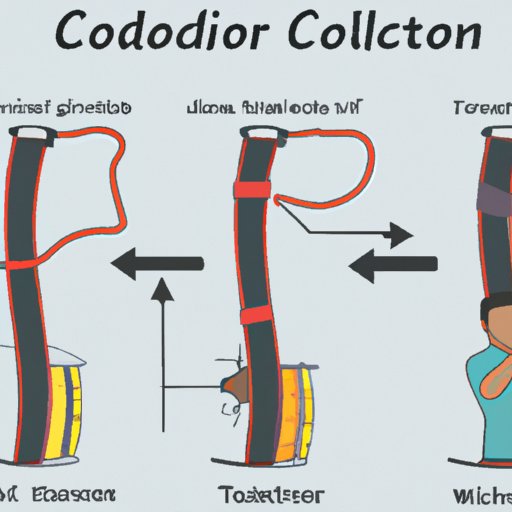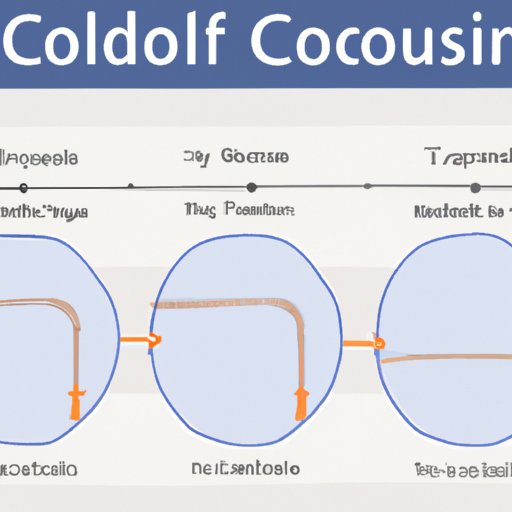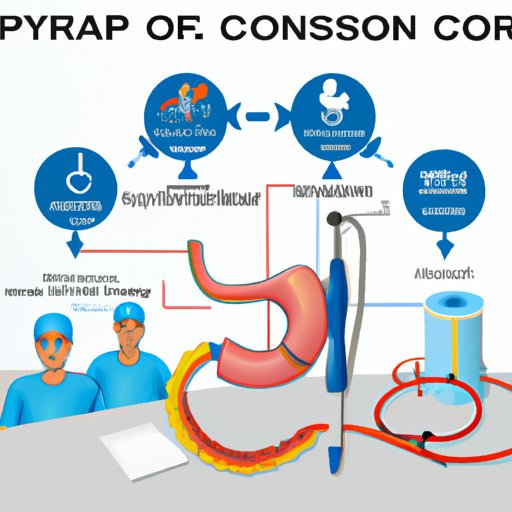Introduction
A colonoscopy is a medical procedure that enables doctors to examine the inside of the large intestine (colon) and rectum. It’s used to identify and diagnose certain health conditions, such as colorectal cancer, polyps or ulcerative colitis. It can also be used to detect any abnormalities or changes in the lining of the colon.
The purpose of this article is to explore how long a colonoscopy takes from start to finish. This includes understanding the various stages of the procedure, the factors that may influence its duration, and what to expect during the process.
A Step-by-Step Guide to the Colonoscopy Process
Before undergoing a colonoscopy, it’s important to understand the different stages of the procedure. This will help you prepare for the exam and ensure it goes as smoothly as possible.
Preparing for Your Colonoscopy
In order to obtain a clear view of the colon, your doctor may require you to take a special diet or laxatives prior to the procedure. This will help to clean out the intestines and make it easier for the doctor to examine the area. Depending on the instructions provided by your doctor, this stage of the process can take anywhere from one to seven days.
Additionally, you may be asked to fast for eight hours before the colonoscopy. This means no food or liquids, with the exception of water. You may also need to arrange for someone to drive you home after the procedure.
During the Colonoscopy
Once you arrive at the hospital or clinic, you will be asked to change into a hospital gown and lie down on the examination table. Depending on the type of anesthesia used, you may be given medication to help you relax before the procedure begins.
The insertion of the colonoscope – a thin, flexible tube with a light and camera on the end – is the next step. The colonoscope is inserted into the anus and slowly guided up through the rectum and into the colon. During the procedure, your doctor will use the camera to look for any abnormalities or changes to the lining of the colon.
If necessary, your doctor may take a biopsy sample – a small piece of tissue – for further testing. This is usually done if they identify any polyps or other growths that could be cancerous. The sample will then be sent to a laboratory for analysis.
After the Colonoscopy
Once the procedure is complete, the colonoscope will be removed and you will be taken to a recovery room to rest. You may feel some discomfort or cramping in the abdomen, but this should subside soon after the procedure.
You will be monitored for any signs of complications and instructed to refrain from eating or drinking until the effects of the anesthesia have worn off. Depending on the type of anesthesia used, this could take anywhere from 30 minutes to several hours.
How Long Does a Colonoscopy Take from Start to Finish?
Colonoscopies can typically take anywhere from 45 minutes to two hours, depending on the individual and the complexity of the procedure. However, there are several factors that can affect the length of time it takes for a colonoscopy to be completed.
Factors That Influence the Length of Time
According to the American Society for Gastrointestinal Endoscopy, the length of time it takes to perform a colonoscopy depends on several factors, including the patient’s age and physical condition, the size and shape of the patient’s colon, and the number of polyps present. Additionally, the type of anesthesia used and the experience level of the doctor performing the procedure can also influence the duration of the colonoscopy.
Typical Timeline for a Colonoscopy Procedure
The typical timeline for a colonoscopy procedure includes the following steps:
- Pre-examination: Preparing for the procedure, which includes taking medications or laxatives, fasting for 8 hours, and arranging for transportation.
- Examination: Insertion of the colonoscope, examination of the colon, and any biopsies that may be taken.
- Post-examination: Recovery period and monitoring for any complications.
What to Expect During Your Colonoscopy Procedure
Before undergoing a colonoscopy, it’s important to discuss your options with your doctor. This includes deciding on the type of anesthesia to be used during the procedure.
Anesthesia Options
Colonoscopies can be performed using either general anesthesia or conscious sedation. General anesthesia will put you to sleep for the entire procedure, while conscious sedation will keep you awake but relaxed. Your doctor will be able to advise you on the best option for you based on your medical history.
The Insertion of the Colonoscope
Once the anesthesia has taken effect, your doctor will begin the procedure by inserting the colonoscope into your anus and slowly guiding it up through the rectum and into the colon. You may feel some pressure or cramping during this process, but it should not be painful.
Biopsy Sampling
If your doctor finds any polyps or other growths during the examination, they may take a biopsy sample for further testing. This involves removing a small piece of tissue from the affected area.

A Breakdown of the Different Stages of a Colonoscopy
A colonoscopy procedure consists of three distinct stages: pre-examination, examination, and post-examination.
Pre-Examination
The pre-examination stage of a colonoscopy involves preparing for the procedure. This includes taking medications or laxatives to clean out the intestines, fasting for 8 hours before the procedure, and arranging for transportation.
Examination
The examination stage is when the colonoscope is inserted into the anus and slowly guided up through the rectum and into the colon. Your doctor will use the camera to look for any abnormalities or changes to the lining of the colon. If necessary, a biopsy sample may be taken for further testing.
Post-Examination
The post-examination stage involves monitoring for any complications and instructing the patient not to eat or drink until the effects of the anesthesia have worn off. Depending on the type of anesthesia used, this could take anywhere from 30 minutes to several hours.

An Overview of the Timeline for a Colonoscopy Procedure
The typical timeline for a colonoscopy procedure is as follows:
- Pre-examination: 1-7 days
- Examination: 45 minutes to 2 hours
- Post-examination: 30 minutes to several hours
Conclusion
A colonoscopy is an important medical procedure used to detect and treat certain health conditions. The length of time it takes to perform a colonoscopy varies depending on the individual and the complexity of the procedure, but typically takes between 45 minutes to two hours.
It’s important to understand the different stages of the procedure and the factors that may influence its duration. By knowing what to expect and taking the necessary preparations, you can ensure that the procedure goes as smoothly as possible.
(Note: Is this article not meeting your expectations? Do you have knowledge or insights to share? Unlock new opportunities and expand your reach by joining our authors team. Click Registration to join us and share your expertise with our readers.)
